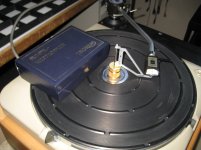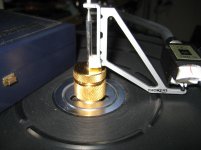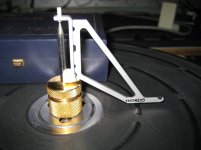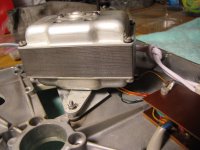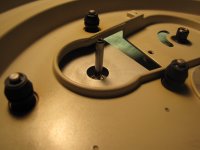These? There should be three.
http://www.schopper.ch/uploads/images/Thorens/Kits und Belts/TD_4005_a.JPG
http://www.schopper.ch/uploads/images/Thorens/Kits und Belts/TD_4005_a.JPG
I'm in the process of rebuilding the motor now, but guess what?
I made the stupid mistake of NOT taking any pictures while disassembling, thinking I'd rely on web pics.... 🙁
Now I have two extra washers that I can't figure where they're going... they're the red-brown bakelites in the bottom of the picture. (sorry, I can't upload pictures yet I guess, not enough posts???)
I can't see them in the pics of this rebuild either: ƒg�[ƒŒƒ“ƒX THORENS model TD 124
Does anyone have any ideas? Thanks in advance.
Should be able to upload - your picture may just be too large. Please try to post a picture as I have rebuilt 4 of these motors and might know when I see them. Most motors have two lock washers on the nuts on the screws that are not attached to the standoffs. Some very early motors might have had fiber washers instead?
Last edited:
These? There should be three.
http://www.schopper.ch/uploads/images/Thorens/Kits und Belts/TD_4005_a.JPG
Nope, not those... those seem to be for the motor suspension, and I have those secured in a ziploc, and also have a new improved (mkII) suspension waiting to be installed.
Should be able to upload - your picture may just be too large. Please try to post a picture as I have rebuilt 4 of these motors and might know when I see them. Most motors have two lock washers on the nuts on the screws that are not attached to the standoffs. Some very early motors might have had fiber washers instead?
You were right... pic was too big. I hope this will do!
Like I said, they're brown-reddish, kind of Bakelite, maybe fiber like you suggested.
Attachments
Last edited:
Check if these fit the motor shaft, I've seen at least one early motor that had a washer or two on top of the rotor. (Internally, but never on the bottom!)
A little noise-hunting trick I am using may be of interest. My arm can be lowered so that the needle rests just to the left of the libelle (bubble level).
That way, the arm becomes a transponder for the noise of the machinery that comes through to the arm.
I've found that using this plus speed changes, helps me isolate the source of a noise. Sometimes, it's hard to tell whether it's the motor/motor pulley, belt, step pulley or idler wheel/platter that's the source of a noise that comes through.
If the noise changes in period when you change the speed of the platter, then you know it has to be the idler wheel/platter that's generating noise.
If the noise remains constant, then you know it's somewhere from the motor to the step pulley the problem lies. I can then experiment in stages. For instance, by removing the belt - if the noise remains, it's in the motor assemply. If it's gone, it's in a later stage.
Add belt - if noise appears, it's either the belt or the step pulley.
Add idler wheel - if noise appears, you know it's the source - either from the contact with the step pulley, or due to how it rests on its pulley.
Add platter, and you know it's the interaction between idler wheel/platter if the noise appears.
Be very careful with the arm and needle. If your arm doesn't allow this due to limitations of the mount, don't force anything.
But this method has helped me eliminate a lot of noise from my turntable in just a few days. I now have idler-wheel/platter noise to deal with, and it has a period that is equal to a little vertical wobble in the idler wheel. So if I can get rid of that wobble, then the noise (which is now very low at high amplification after greasing the idler wheel bearing) will be constant.
This also helps me focus on noise that gets through to the needle and amplifier. I have the regular Thorens motor whirr that comes with a new belt, but that will eventually disappear, and has also gotten a lot weaker after two weeks of use, after stretching the belt.
But using the needle to diagnose the location of a noise helped me target my efforts significantly. I understand some are also using the clutch to stop the record, and then dropping the needle on to it, but I think that will give misleading results, as the clutch plates will possibly be transmitting noise that is not there when the top platter is running freely without being in contact with the plates.
I now have to see if I can get rid of that vertical wobble on the idler wheel, as I will then have a regular noise, and at very low strength coming through. I'm using loud amplification - not quite the amp's max, but then I never listen at the level I'm using for the test.
(My player's actually recently been refurbished, but was quite noisy when it came to me compared to how it's playing now.)
That way, the arm becomes a transponder for the noise of the machinery that comes through to the arm.
I've found that using this plus speed changes, helps me isolate the source of a noise. Sometimes, it's hard to tell whether it's the motor/motor pulley, belt, step pulley or idler wheel/platter that's the source of a noise that comes through.
If the noise changes in period when you change the speed of the platter, then you know it has to be the idler wheel/platter that's generating noise.
If the noise remains constant, then you know it's somewhere from the motor to the step pulley the problem lies. I can then experiment in stages. For instance, by removing the belt - if the noise remains, it's in the motor assemply. If it's gone, it's in a later stage.
Add belt - if noise appears, it's either the belt or the step pulley.
Add idler wheel - if noise appears, you know it's the source - either from the contact with the step pulley, or due to how it rests on its pulley.
Add platter, and you know it's the interaction between idler wheel/platter if the noise appears.
Be very careful with the arm and needle. If your arm doesn't allow this due to limitations of the mount, don't force anything.
But this method has helped me eliminate a lot of noise from my turntable in just a few days. I now have idler-wheel/platter noise to deal with, and it has a period that is equal to a little vertical wobble in the idler wheel. So if I can get rid of that wobble, then the noise (which is now very low at high amplification after greasing the idler wheel bearing) will be constant.
This also helps me focus on noise that gets through to the needle and amplifier. I have the regular Thorens motor whirr that comes with a new belt, but that will eventually disappear, and has also gotten a lot weaker after two weeks of use, after stretching the belt.
But using the needle to diagnose the location of a noise helped me target my efforts significantly. I understand some are also using the clutch to stop the record, and then dropping the needle on to it, but I think that will give misleading results, as the clutch plates will possibly be transmitting noise that is not there when the top platter is running freely without being in contact with the plates.
I now have to see if I can get rid of that vertical wobble on the idler wheel, as I will then have a regular noise, and at very low strength coming through. I'm using loud amplification - not quite the amp's max, but then I never listen at the level I'm using for the test.
(My player's actually recently been refurbished, but was quite noisy when it came to me compared to how it's playing now.)
Last edited:
A little noise-hunting trick I am using may be of interest. My arm can be lowered so that the needle rests just to the left of the libelle (bubble level).
That way, the arm becomes a transponder for the noise of the machinery that comes through to the arm.
I've found that using this plus speed changes, helps me isolate the source of a noise. Sometimes, it's hard to tell whether it's the motor/motor pulley, belt, step pulley or idler wheel/platter that's the source of a noise that comes through.
If the noise changes in period when you change the speed of the platter, then you know it has to be the idler wheel/platter that's generating noise.
If the noise remains constant, then you know it's somewhere from the motor to the step pulley the problem lies. I can then experiment in stages. For instance, by removing the belt - if the noise remains, it's in the motor assemply. If it's gone, it's in a later stage.
Add belt - if noise appears, it's either the belt or the step pulley.
Add idler wheel - if noise appears, you know it's the source - either from the contact with the step pulley, or due to how it rests on its pulley.
Add platter, and you know it's the interaction between idler wheel/platter if the noise appears.
Be very careful with the arm and needle. If your arm doesn't allow this due to limitations of the mount, don't force anything.
But this method has helped me eliminate a lot of noise from my turntable in just a few days. I now have idler-wheel/platter noise to deal with, and it has a period that is equal to a little vertical wobble in the idler wheel. So if I can get rid of that wobble, then the noise (which is now very low at high amplification after greasing the idler wheel bearing) will be constant.
This also helps me focus on noise that gets through to the needle and amplifier. I have the regular Thorens motor whirr that comes with a new belt, but that will eventually disappear, and has also gotten a lot weaker after two weeks of use, after stretching the belt.
But using the needle to diagnose the location of a noise helped me target my efforts significantly. I understand some are also using the clutch to stop the record, and then dropping the needle on to it, but I think that will give misleading results, as the clutch plates will possibly be transmitting noise that is not there when the top platter is running freely without being in contact with the plates.
I now have to see if I can get rid of that vertical wobble on the idler wheel, as I will then have a regular noise, and at very low strength coming through. I'm using loud amplification - not quite the amp's max, but then I never listen at the level I'm using for the test.
(My player's actually recently been refurbished, but was quite noisy when it came to me compared to how it's playing now.)
I do all of the same things, but recommend a mechanics stethoscope as the listening device or a small screwdriver held to the ear. My observations would be otherwise very similar.
The complexity of this drive system means that there are a couple of extra noise sources compared to either belt drive or pure idler drive. It has to all run close to perfectly for the table to provide the sort of performance of which it is capable. Mine has continued to run quietly for the last couple of months without any significant tweaking.
One important ingredient is to find a belt that does not leave goo all over the pulleys -noting that some very inexpensive belts from a gentleman in Hollywood FLA (eBay) are excellent in this regard (and others) and the current OEM belt which I am no longer using definitely is not.
On my TD 124 I get a low whirr which can be heard from a couple of feet away. I have diagnosed the cause to be the belt, which is just a touch too tight. I see recommendations here that it should be as loose as possible, and should be stretched overnight on a coffee can...
When I hold a cotton ball against the capstan on the engine pulley, and apply very soft pressure in the direction of the engine spindle, away from the intermediate pulley, the whirr instantly disappears and the engine becomes completely silent.
This could support the notion that the belt is pulling at the engine; or else it could be that the very light pressure I apply is sufficient to dampen the whirr. I lean towards the first option. i have stretched the belt a little, to the point that it is now looser, and that has reduced the whirr. If I stretch it more, I fear it will become too loose.
What options are there for adjusting the vibration in the engine? It's perfectly silent after the barest of slight/little/minuscule pressure against the capstan, and it seems silly not to be able to have that silence be a feature.
Last edited:
A unexpected noise source can be the bearings from the steppulley remember this pulley is running on high speed about 700 rpm !
When you check the bearingaxis you see mosttimes traces from wear and a dip on the topbottom axis, with polishing you can restore that.
You can be fooled that it is a belt problem but worn steppulley bearings can make a lot noise best to replace the two.
Checking this without platter give no good results because the idler is running between them .
When you check the bearingaxis you see mosttimes traces from wear and a dip on the topbottom axis, with polishing you can restore that.
You can be fooled that it is a belt problem but worn steppulley bearings can make a lot noise best to replace the two.
Checking this without platter give no good results because the idler is running between them .
Kevin these speed measurements are done with a testrecord with a 3 khz level 5,42 cm/sec, and a response testunit from B@K 4416 to a FFT HP analyzer 35665a .
The measurement span is 200 Hz so you can see the peaks and read the frequence on the horizontal axis 40 Hz per div., vertical the level 10 db per div.
In another posting I made a compare between a Linn LP12 and TD124.
For rumble measurements I use no record for the same reason as you but use the Thorens Rumpel koppler and a B@K accelero meter with good results but the environment must be quiet.
I have done some measurements between the TD124 with E50 motor and Papst motor which I shall post these days , they are done with the accelerometer.
The measurement span is 200 Hz so you can see the peaks and read the frequence on the horizontal axis 40 Hz per div., vertical the level 10 db per div.
In another posting I made a compare between a Linn LP12 and TD124.
For rumble measurements I use no record for the same reason as you but use the Thorens Rumpel koppler and a B@K accelero meter with good results but the environment must be quiet.
I have done some measurements between the TD124 with E50 motor and Papst motor which I shall post these days , they are done with the accelerometer.
Please post them ....
Hello Volken,
I would like to see those measurements in regards to the Papst and E50 motor. But, since the Papst is a 3-phase unit, and the E50 is not, are you going to run the Papst off of a true 3-phase source? And where did you get a Thorens Rumpel koppler ? Could you post closeups of it? I wouldn't mind making one, if it is possible.
Regards,
Gene
Hello Volken,
I would like to see those measurements in regards to the Papst and E50 motor. But, since the Papst is a 3-phase unit, and the E50 is not, are you going to run the Papst off of a true 3-phase source? And where did you get a Thorens Rumpel koppler ? Could you post closeups of it? I wouldn't mind making one, if it is possible.
Regards,
Gene
Kevin these speed measurements are done with a testrecord with a 3 khz level 5,42 cm/sec, and a response testunit from B@K 4416 to a FFT HP analyzer 35665a .
The measurement span is 200 Hz so you can see the peaks and read the frequence on the horizontal axis 40 Hz per div., vertical the level 10 db per div.
In another posting I made a compare between a Linn LP12 and TD124.
For rumble measurements I use no record for the same reason as you but use the Thorens Rumpel koppler and a B@K accelero meter with good results but the environment must be quiet.
I have done some measurements between the TD124 with E50 motor and Papst motor which I shall post these days , they are done with the accelerometer.
Thorens Rumpel Messkoppler
Gene here are some pictures from the messkoppler we bought this when Thorens came with it on the market .
Nowadays it is a rare item I have not seen it often , most European HiFi magazines using them still for rumble measurements.
The measurements on the Papst motor is done with three fase supply and normal because most people are not using a separate supply.
We build also a single supply for the E50 motor because the motor is better running on 200Volt then the 230 Volt we have here now .
Especially after revision the motor is running very smooth so we must set the magnetic breake on max.for the right speed this give no good results on the performance .
The motor is running full and the brake is on max with the externeral drive
on 200Volt you get a very good speed stability , measurements and the human ear confirm this .
Gene here are some pictures from the messkoppler we bought this when Thorens came with it on the market .
Nowadays it is a rare item I have not seen it often , most European HiFi magazines using them still for rumble measurements.
The measurements on the Papst motor is done with three fase supply and normal because most people are not using a separate supply.
We build also a single supply for the E50 motor because the motor is better running on 200Volt then the 230 Volt we have here now .
Especially after revision the motor is running very smooth so we must set the magnetic breake on max.for the right speed this give no good results on the performance .
The motor is running full and the brake is on max with the externeral drive
on 200Volt you get a very good speed stability , measurements and the human ear confirm this .
Attachments
Kevin these speed measurements are done with a testrecord with a 3 khz level 5,42 cm/sec, and a response testunit from B@K 4416 to a FFT HP analyzer 35665a .
The measurement span is 200 Hz so you can see the peaks and read the frequence on the horizontal axis 40 Hz per div., vertical the level 10 db per div.
In another posting I made a compare between a Linn LP12 and TD124.
For rumble measurements I use no record for the same reason as you but use the Thorens Rumpel koppler and a B@K accelero meter with good results but the environment must be quiet.
I have done some measurements between the TD124 with E50 motor and Papst motor which I shall post these days , they are done with the accelerometer.
Just the information I was looking for and confirms exactly what I suspected.
Thanks! 😀
OK, I'll try a couple of configurations and take pictures...
I finally resolved the washers problem... top and bottom of the rotor, around the shaft before re-installing it in the bearings...
The motor is re-assembled and re-installed on the tt via a MKII suspension kit, and, EUREKA, it spins... Also changed the old power cord..
To my ears, minimal noise, but I don't have a stethoscope. After cutting the power, the shaft spins for about 10 secs.
Here are a few pictures:
Attachments
Last edited:
After playing with the bearings alignment and letting the motor run for about 30 min., it's now fairly silent and spins for over 20 secs. when cutting the power. 🙂
After playing with the bearings alignment and letting the motor run for about 30 min., it's now fairly silent and spins for over 20 secs. when cutting the power. 🙂
This sounds good. Check and top up the lubrication periodically while the motor runs in - less necessary if you really soaked the felts good during installation. Sometimes during run-in if there is insufficient lubrication the motor will start to seize, this will be quite obvious if it happens, and depends very heavily on how well oil impregnated your new bearings were prior to installation. This has happened to me with no apparent harm to bearings or motor shaft (inspect) as long as it is not allowed to run this way for any appreciable amount of time.
.....I have done some measurements between the TD124 with E50 motor and Papst motor which I shall post these days , they are done with the accelerometer.
Hi Volken.
I look forward to your analysis of the Pabst motor for the TD124.
I have one of these sitting on the shelf waiting to be used...again.

I'm sure what the Pabst really needs is a true 3 phase power supply to tame its tendency to vibrate the TD124 chassis.
I did try this motor by following the information sheet provided by Thorens for setup. This sheet recommends a "hack" which uses a capacitor to provide a crude timing mechanism for the motor to run. But the result is a 3 - phase motor running on single phase power...😱
In my experience it runs rough in comparison to the stock E50. But it does provide some added energy to the propulsion system. The tt was much more forward sounding and offered greater output of musical energy. Too bad the motor put a wet blanket over the mids and highs. (more than just a vail to be lifted..

Here are some of my notes on my first trial with the Pabst on a TD124:
Papst Aussenlaufer
Do keep us posted on your trials with the Pabst. I'd love to find a 3 phase PS for this interesting motor. I've got a spare TD124 chassis just waiting for another go around.
-Steve
Steve, have a look at this: Automation Stock > SIEMENS Drives > Siemens MM410 Variable Frequency DrivesHi Volken.
I look forward to your analysis of the Pabst motor for the TD124.
I have one of these sitting on the shelf waiting to be used...again.

I'm sure what the Pabst really needs is a true 3 phase power supply to tame its tendency to vibrate the TD124 chassis.
<snip>
Do keep us posted on your trials with the Pabst. I'd love to find a 3 phase PS for this interesting motor. I've got a spare TD124 chassis just waiting for another go around.
-Steve
The Siemens MM420 (200V - 480V input) is apparently commonly used in some European circles for running the three phase motors in EMT tables. I'd think the MM410 would do about as well on 120V for the US version (only) of the papst motor in a TD-124, and I've seen these used on eBay for relatively little money. I've not tried one so take all of this with a grain of salt.
Steve, have a look at this: Automation Stock > SIEMENS Drives > Siemens MM410 Variable Frequency Drives
The Siemens MM420 (200V - 480V input) is apparently commonly used in some European circles for running the three phase motors in EMT tables. I'd think the MM410 would do about as well on 120V for the US version (only) of the papst motor in a TD-124, and I've seen these used on eBay for relatively little money. I've not tried one so take all of this with a grain of salt.
I've seen those but am at a loss how to implement one to the application. Guess I'd need a step-by-step tutorial on how to lash one of those up.
-Steve
I've seen those but am at a loss how to implement one to the application. Guess I'd need a step-by-step tutorial on how to lash one of those up.
-Steve
You need to get the 410 and either the simple or complex interface, and in this application I believe all you need to do is set the voltage and frequency using the interface. The manual spells this out in some detail, and it is then literally set and forget. Most of the more advanced options are not needed for this application.
The wiring is quite simple too and the manual explains how to do that in some detail.
- Home
- Source & Line
- Analogue Source
- Restoring and Improving A Thorens TD-124 MKII

